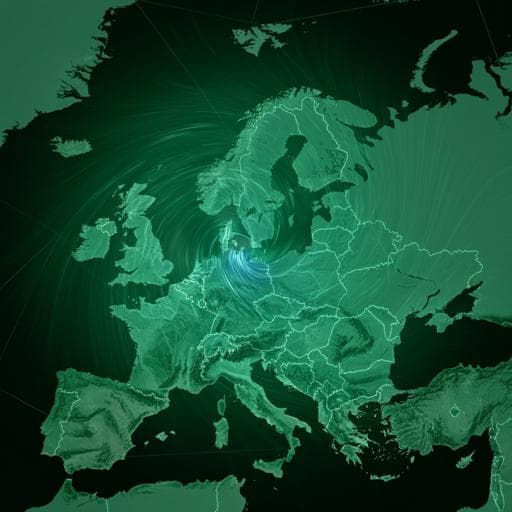
Environmental Studies and Forestry
The European Green Deal and turbulence for non-member states
M. D. Leiren and F. Farstad
This article by Merethe Dotterud Leiren and Fay Farstad explores the fascinating impacts of the European Green Deal on non-member states like Norway and the UK. Discover how varying levels of EU affiliation influence the turbulence faced by these countries and their remarkable capacity for adaptation.
~3 min • Beginner • English
Introduction
The European Green Deal (EGD) represents the world’s first large-scale, cross-sector climate governance strategy aiming for net-zero greenhouse gas emissions by 2050, with an EU Climate Act setting a −55% net emissions goal by 2030 compared to 1990. Through the Fit for 55 (Ff55) package, the EU has rapidly revised and introduced policies spanning the EU ETS (now including maritime shipping), the Effort Sharing Regulation (ESR), LULUCF, the Renewable Energy Directive, the Energy Efficiency Directive, transport laws, a new ETS for buildings and road transport (ETS 2), and the Carbon Border Adjustment Mechanism (CBAM). This ambitious, fast-moving agenda creates a ‘new normal’ of turbulent governance as events, demands, and support interact unpredictably, posing challenges for planning, implementation, and balancing climate ambition with social and economic considerations. Existing literature on turbulence in EU climate policy largely focuses on EU institutions and member states. This study examines how the EGD affects non-member states, asking: Does the EGD create turbulence in non-member states? If so, what is its nature? Does it vary with the degree of EU affiliation? The analysis compares Norway (closely integrated through the EEA and cooperative on climate policy) and the UK (post-Brexit, aligned through the Trade and Cooperation Agreement but seeking sovereignty, outside EU ETS and EU institutions). Drawing on three dimensions of turbulence—shifting parameters, intercurrence, and temporal complexity—the study develops expectations about how affiliation shapes turbulence. It anticipates the UK to face greater turbulence from shifting parameters (due to alignment with fewer resources), the UK to face more intercurrence (due to institutional separation and sovereignty goals), and Norway to face more temporal complexity (due to closer cooperation and the speed of EU legislative change). These expectations are embedded in turbulence of scale, recognizing that EU-level decisions can be suboptimal or contentious at national levels, with potentially greater overall impact on Norway given closer ties, though with variation across the three dimensions.
Literature Review
The study engages with an emerging literature on climate governance turbulence, notably Ansell and Trondal’s framework emphasizing shifting parameters, intercurrence, and temporal complexity. It situates the EGD within broader debates on rapid policy change, crises (e.g., COVID-19, energy crisis post-Ukraine invasion), and politicization (e.g., farmers’ protests, party campaigns challenging EU climate measures). Prior analyses have focused on EU-level or member-state dynamics, leaving a gap on non-members. The paper also draws on Kingdon’s multiple streams and policy community cohesion, suggesting unity fosters effectiveness, and on work examining EU influence on third countries, market versus technology-development logics (Boasson), and the evolving EU state aid regime’s implications. It references scholarship on Brexit’s environmental governance implications (non-regression, regulatory gaps, de-Europeanization risks) and the role of the UK as a historical driver of EU climate ambition, highlighting the need to assess how the EGD’s design and pace reverberate beyond EU borders.
Methodology
The study employs a qualitative, comparative design (Most Similar Systems Design) focusing on two least-likely cases—Norway and the UK—both non-EU climate leaders with liberalized energy markets and ambitious goals resembling the EU’s, but with different EU affiliations (Norway: EEA-integrated and aligned on climate/energy acquis; UK: post-Brexit TCA, outside EU mechanisms). Evidence was gathered through extensive document analysis (academic literature, grey literature, consultation responses, media) and ten semi-structured elite interviews with stakeholders across Norway, the UK, and Brussels (energy industry representatives, environmental organizations, Norwegian ministries, a former UK Cabinet minister, and a UK civil servant) conducted between March 2022 and May 2024. The research is complemented by a policy roundtable (Oslo, Dec 1, 2021) and two stakeholder workshops (Oct 29, 2021 online; Feb 28, 2023 in Oslo) under Chatham House Rules, primarily with Norwegian stakeholders but including some UK/EU perspectives. Ethical approval was obtained from the Norwegian Agency for Shared Services in Education and Research; informed consent procedures and data protection standards were followed. The analysis operationalizes turbulence along three dimensions—shifting parameters, intercurrence, and temporal complexity—to compare how EGD-induced changes manifest in each country and how institutional structures and strategies adapt under turbulent conditions.
Key Findings
Overall finding: Both Norway and the UK experience EGD-induced turbulence, but Norway more so, despite both having ambitious climate policies and similar targets. Four key reasons for Norway’s higher turbulence: (1) Administrative capacity: the UK has a larger, more flexible public administration; Norway’s smaller administration faces significant strain. (2) Policy development history: UK officials participated in shaping some Ff55 elements pre-Brexit; Norway was less involved. (3) Political orientation: UK governments focused on delivering Brexit rather than tracking Brussels closely; Norway struggles with being simultaneously ‘outside and inside’ the EU, creating turbulence as the EGD expands into more areas and EU membership remains contested. (4) Nature of pressure: Norway faces coercive pressures to implement EGD-driven legislation via EEA mechanisms; the UK faces mainly competitive pressures to align under the TCA’s limited non-regression clause (Article 391 applies only insofar as trade and investment are affected). Shifting parameters: • Norway: Significant capacity and budget pressures reported by agencies (e.g., Environment Agency cites unprecedented legislative tempo). Inclusion of shipping in EU ETS nearly doubles covered actors, creating major administrative burdens (verification, reporting, guidance), while offering opportunities in green maritime tech (e-ferries). Financial implications include a NOK 5.5 billion contribution obligation to the Social Climate Fund via ETS 2 revenues, with uncertainty (as of May 2024) about eligibility to benefit; conversely, three Norwegian hydrogen/CCS projects gained PCI status, improving funding opportunities. Political support is challenged by rising energy prices and debates over interconnectors and wind power in a hydropower-based, historically low-price system. LULUCF revisions (stricter binding 2030 targets) imply potential constraints on deforestation, logging, and land use, drawing strong opposition from forestry interests and signaling centralization of forest policy. CBAM-linked phase-out of free allowances by 2034 raises leakage concerns for power-intensive industries (aluminium, fertilizers). • UK: Post-Brexit stance rejects EU rule-taking; the UK must develop its own ETS and targets (e.g., UK ETS expansion to domestic shipping from 2026). Consultations highlight the importance of alignment with EU ETS to avoid market distortions and carbon cost differentials. ‘Zombie legislation’ concerns reflect governance gaps post-Brexit, though this is more a Brexit than EGD effect. EGD-driven EU funding streams (e.g., SCF, PCI) confer competitive advantages to EU/EEA actors; UK loses access, adding alignment and monitoring burdens and costs (e.g., CBAM compliance) atop Brexit impacts. However, the UK’s large administrative machinery mitigates turbulence. Intercurrence: • Relaxed EU state aid rules under EGD mark a shift from strict competition policy, challenging the EEA’s level-playing-field logic and potentially benefiting both Norwegian and UK green projects, while creating tensions for market-focused policy traditions (especially sensitive for Norway’s small open economy). • Norway’s siloed administration is stressed by the EGD’s holistic approach; the UK’s more flexible, frequently restructured departments and net-zero governance break silos and distribute responsibilities more effectively. • Potential AFOLU (agriculture + forestry) integration—though not adopted in trilogue—signals future cross-sector entanglement, raising sovereignty dilemmas for Norway (agriculture outside EEA), complicating assessments of EEA relevance and protection of national competencies. • CBAM creates dilemmas: Norway’s participation undecided as of May 2024 (membership in EU ETS would facilitate technical alignment but increases admin costs); UK faces risks of trade barriers into the EU without a compatible CBAM and is moving to implement a UK CBAM by 2027. UK steel warns of EU market access risks without rapid action. Despite geopolitical drivers pushing cooperation (REPowerEU context), the UK’s policy agenda references the EGD less than the US IRA, reflecting an autonomy narrative. Temporal complexity: • Norway: The EGD’s rapid policymaking reduces Norway’s ability to influence upstream via expert groups and corridor diplomacy, limits domestic debate (low parliamentary/media attention), and enlarges an implementation backlog, particularly in energy. Delays on the Energy Performance of Buildings Directive (taxonomy-aligned criteria) risk investor funding, and Norway was pressed in April 2024 to implement the 2018 Renewable Energy Directive (already revised again in 2023). • UK: Also challenged by EU policymaking speed but has weaker channels for upstream influence post-Brexit and often reacts late. Its larger, flexible bureaucracy enables faster domestic policy responses (e.g., proposing a UK CBAM), aided by pre-Brexit groundwork on concepts like CBAM. Additional data points: • Norway’s GHG emissions fell 9.1% from 1990 to 2023, with 4.7% reduced between 2022–2023. • UK ETS planned maritime inclusion from 2026; EU ETS free allocation phase-out by 2034; UK CBAM targeted by 2027; Norway’s SCF contribution obligation: NOK 5.5 billion. Despite turbulence, both countries’ climate and energy policy orientations and EU cooperation remain broadly stable, though with dilemmas: Norway faces public support challenges and sectoral controversies; the UK risks suboptimal, higher-cost alignment outside EU frameworks.
Discussion
The research questions asked whether the EGD creates turbulence for non-member states, its nature, and variation by EU affiliation. The findings show that the EGD does generate turbulence in both non-members, with Norway experiencing more turbulence overall, contrary to initial expectations for shifting parameters and intercurrence. Norway’s close institutional coupling exposes it to coercive, rapid, and cross-sectoral EU changes without full member-state buffering mechanisms, straining administrative capacity, politicizing sensitive sectors (e.g., LULUCF, energy prices, wind power), and compounding implementation backlogs. The UK, while outside EU institutions, confronts competitive pressures to maintain alignment for trade and climate leadership, but its larger, flexible bureaucracy and autonomy narrative diffuse some turbulence and permit bespoke responses (e.g., UK CBAM). The expected pattern for temporal complexity is confirmed: speed and scope of EGD decision-making particularly disrupt Norway’s influence channels and domestic deliberation; the UK also struggles with speed but compensates administratively. These results refine turbulence theory by highlighting how closeness to a powerful policymaking center can heighten non-member turbulence through coercive pathways, while distance shifts pressures toward competition and administrative alignment challenges. Policy significance includes anticipating and resourcing for administrative load, safeguarding democratic deliberation under rapid timelines, and designing cross-border mechanisms (ETS, CBAM, state aid) with third-country implications in mind. The EU’s strategic use of tools like CBAM and deforestation rules broadens turbulence beyond immediate neighbors, suggesting that non-member effects are integral to EGD governance dynamics.
Conclusion
The study demonstrates that the EGD induces turbulence in non-member states, with degree and nature varying by EU affiliation. Contrary to expectations for shifting parameters and intercurrence, the more closely affiliated non-member (Norway) experiences greater turbulence overall, due to coercive implementation pressures, cross-sectoral entanglement, and the rapid tempo of EU lawmaking that challenges influence and domestic processes. The UK faces notable but relatively less turbulence, shaped by competitive alignment pressures and mitigated by its administrative capacity and autonomy framing, while still needing to manage trade-related mechanisms (e.g., UK CBAM) and funding disadvantages. The EGD’s scope and speed can pull closely affiliated non-members into its vortex without providing full member-state stabilizers. Contributions include extending turbulence analysis to non-members and clarifying coercive versus competitive pressure pathways. Future research should (a) examine impacts beyond Europe’s immediate neighbors, (b) conduct sector- and instrument-specific deep dives (e.g., CBAM, LULUCF, ETS 2), (c) undertake more systematic and quantitative studies across broader samples, and (d) investigate reciprocal impacts on the EU as non-members respond to EGD externalities.
Limitations
The analysis is exploratory and based on two case studies, prioritizing breadth across multiple EGD components over depth within specific sectors or instruments. It relies on qualitative evidence (documents, 10 elite interviews, a policy roundtable, and two stakeholder workshops), which may introduce selection and perception biases despite triangulation. The study does not systematically assess organizational response capacities across public administrations, and it does not analyze in depth the feedback effects on the EU of non-member responses. Norway-focused stakeholder activities and data availability may bias emphasis toward Norwegian dynamics. Timing constraints relative to ongoing EGD implementation and evolving UK policies (e.g., CBAM design) limit generalizability and may render some findings subject to change.
Related Publications
Explore these studies to deepen your understanding of the subject.







